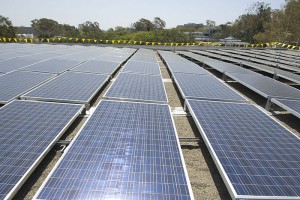Adding to the list of common surfaces in the built environment that are harboring unique microbial communities — solar panels! If you build a smooth surface exposed to the sun, will they come, like poolside sunbathers vying for the best lounge chairs? A study by Pedro Dorado-Morales and crew came at this question from multiple sides: they pulled off samples at the same time of day for 16S/18S rRNA identification, cultured isolated strains to subject them to various stress tests, and ran shotgun metagenomic and proteomic sequencing to get a functional profile.

The functional profile revealed that protein composition not only varied between night and day but included a high amount of proteins suspected to play important roles in biofilm formation and resistance to harsh conditions. When compared to a more expansive range of habitats, it clustered with environmental habitats like polar microbial mats and saline deserts. This is important in distinguishing that these microbes are not merely depositional leftovers, but an active community surviving on the solar panels. The stress tests ran on the isolated strains supported this by showing resistance to high salt concentrations, though they showed relatively low resistance to UV light and heat shock. This might be something interesting to follow up on regarding colonization of these surfaces — perhaps those more easily cultured are not entirely representative of the key players that allow a community to survive here. The species identified in the rRNA on the solar panels, a diverse array of around 500 in each sample, also consistently showed high abundance of organisms previously associated with harsh conditions, including the posterchild, Deinococcus.
All in all, I’m interested to see the extent to which these extremophiles occupy environments we walk by every day. If they can survive on the vertical, as well, can you imagine all the relatively young surface area in our cities that endures harsh conditions like these solar panels?
